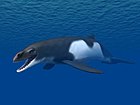Mammalodon is an extinct genus of archaic baleen whale belonging to the family Mammalodontidae.

Mammalodontidae is a family of extinct whales known from the Oligocene of Australia and New Zealand.

Aetiocetus is a genus of extinct basal mysticete, or baleen whale that lived 33.9 to 23.03 million years ago, in the Oligocene in the North Pacific ocean, around Japan, Mexico, and Oregon, U.S. It was first described by Douglas Emlong in 1966 and currently contains known four species, A. cotylalveus, A. polydentatus, A. tomitai, and A. weltoni. These whales are remarkable for their retention of teeth and presence of nutrient foramina, indicating that they possessed baleen. Thus, Aetiocetus represents the transition from teeth to baleen in Oligocene mysticetes. Baleen is a highly derived character, or synapomorphy, of mysticetes, and is a keratinous structure that grows from the palate, or roof of the mouth, of the whale. The presence of baleen is inferred from the fossil record in the skull of Aetiocetus. Aetiocetus is known from both sides of the Pacific Ocean: it was first documented in Oregon, United States, but it is also known from Japan and Mexico. The genus is currently constrained to the Northern hemisphere and has little value in biostratigraphic studies of the Oligocene due to its limited occurrences across the Pacific.

Cetotheriidae is a family of baleen whales. The family is known to have existed from the Late Oligocene to the Early Pleistocene before going extinct. Although some phylogenetic studies conducted by Fordyce & Marx 2013 recovered the living pygmy right whale as a member of Cetotheriidae, making the pygmy right whale the only living cetotheriid, other authors either dispute this placement or recover Neobalaenidae as a sister group to Cetotheriidae.
The Kokoamu Greensand is a geological formation found in New Zealand. It is a fossil-bearing, late Oligocene, greensand rock unit of the eastern South Island, especially the Waitaki District of North Otago and the southern Canterbury region. The formation was named by geologist Maxwell Gage in the 1950s. In North Otago it underlies the thicker and harder Otekaike Limestone. The formation gets its green colour from the mineral glauconite which forms slowly on the ocean floor.
Eomysticetus is an extinct genus of baleen whale from the late Oligocene (Chattian) Chandler Bridge Formation of South Carolina.
Nannocetus is an extinct baleen whale belonging to the family Cetotheriidae.

Otekaikea is an extinct genus of toothed whale closely related to Waipatia. It is known from the late Oligocene (Chattian) of New Zealand.
Mauicetus is a genus of extinct baleen whale from the Late Oligocene of New Zealand.
Tohoraata is a genus of eomysticetid baleen whale from the Late Oligocene (Chattian) of New Zealand. There are two recognized species, T. raekohao and T. waitakiensis.
Eomysticetidae is a family of extinct mysticetes belonging to Chaeomysticeti. It is one of two families in the basal chaeomysticete clade Eomysticetoidea.

Tranatocetus is an extinct genus of mysticete from the late Miocene (Tortonian) of Jutland, Denmark. The type and only species is Tranatocetus argillarius.
Tokarahia is a genus of eomysticetid baleen whale from the Late Oligocene (Chattian) of New Zealand. There are two recognized species, T. kauaeroa and T. lophocephalus.

Aetiocetidae is an extinct family of toothed baleen whales known from the Oligocene and latest Eocene, so far only from rocks deposited in the North Pacific Ocean. The whales ranged in size from 3 to 8 metres long. Many of the described specimens were discovered from the Upper Oligocene of the Japanese Morawan Formation, the largest known one from the Morawan's Upper tuffaceous siltstone. Other formally described extinct toothed mysticetis from this time are smaller, from 3 to 4 metres in length. Mysticeti with true baleen are seen in fossils from the Upper Oligocene. The monophyly of the family is still uncertain, as are the evolutionary relationship between the early toothed baleen whales and the early and extant edentulous baleen whales. However, the cladistic analyses of Coronodon and Mystacodon seem to indicate that Aetiocetidae and Llanocetidae are more closely related to crown Mysticeti than to Mammalodontidae, Coronodon, and Mystacodon.

Waharoa is a genus of eomysticetid baleen whale from the Late Oligocene (Chattian) of New Zealand. It was identified with the discovery of Waharoa ruwhenua by Boessenecker and Fordyce (2015), which added a new genus and species to a monophyletic family Eomysticetidae.
Matapanui is a genus of eomysticetid baleen whale from the Late Oligocene Kokoamu Greensand of New Zealand.
Whakakai is a genus of baleen whale from the Late Oligocene (Chattian) Kokoamu Greensand of New Zealand.
Sitsqwayk is a genus of baleen whale from Late Oligocene (Chattian) marine deposits in Washington state. The generic name refers to a powerful water spirit in the folklore of the Klallam that is said to bring wealth.
Toipahautea is a genus of baleen whale from the Late Oligocene (Chattian) Kokoamu Greensand of New Zealand.











